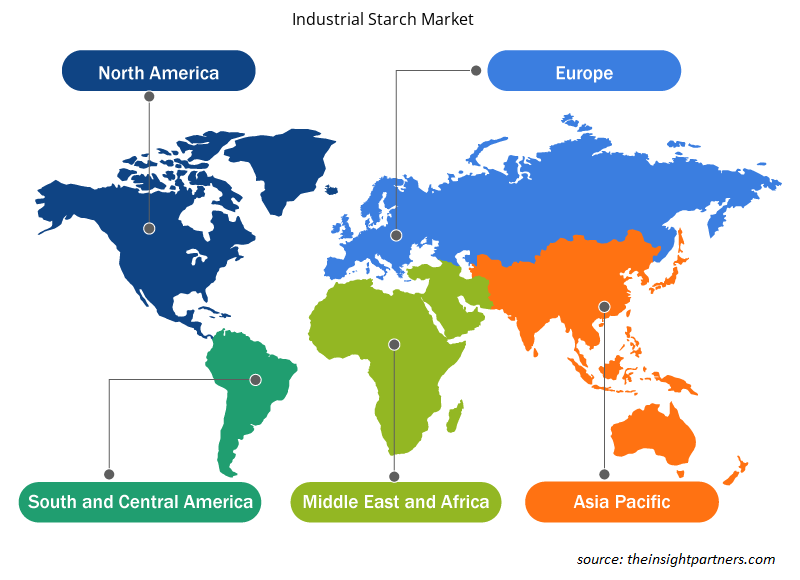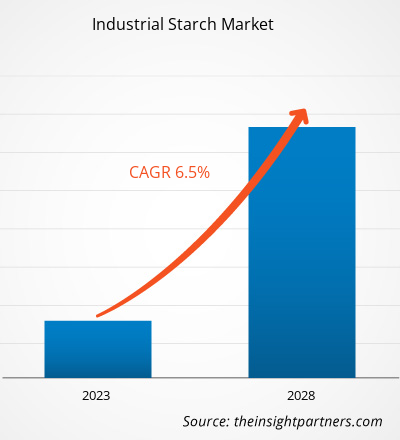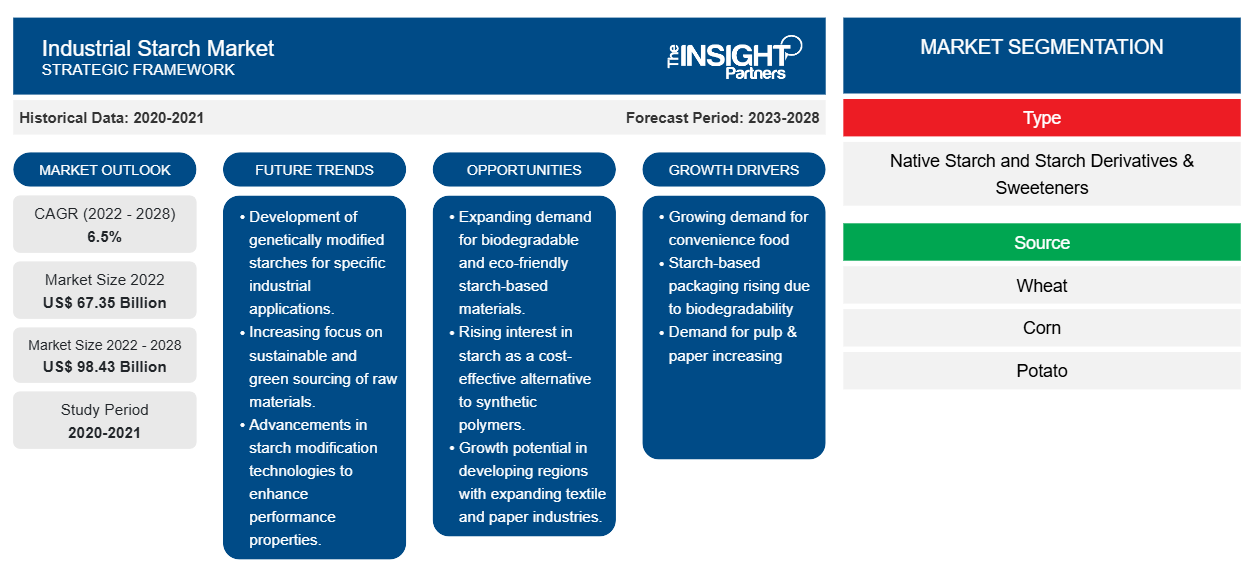[Forschungsbericht] Der Markt für industrielle Stärke soll von 67.353,01 Millionen US-Dollar im Jahr 2022 auf 98.426,74 Millionen US-Dollar im Jahr 2028 wachsen; von 2022 bis 2028 wird mit einer durchschnittlichen jährlichen Wachstumsrate von 6,5 % gerechnet.
Stärke ist ein komplexes Kohlenhydrat, das aus Weizen, Mais, Kartoffeln, Tapioka und Reis gewonnen wird. Sie ist eine großartige Energiequelle. Stärke ist ein Verdickungs-/Geliermittel und Stabilisator in einer Vielzahl von Lebensmitteln und Getränken, darunter Back- und Süßwaren, Suppen, Soßen, gefrorene Desserts, Milchcremes und Fertiggetränke. Die Nachfrage nach Fertiggerichten steigt weltweit aufgrund des hektischen Lebensstils der Verbraucher und des hohen Pro-Kopf-Einkommens. Darüber hinaus benötigen Lebensmittelverpackungen auf Papierbasis eine Beschichtung, um zu verhindern, dass Wasser oder Sauerstoff in die Verpackung eindringt und die Lebensmittel im Inneren verderben. Normalerweise wird diese Schutzbeschichtung aus Kunststoff auf Erdölbasis hergestellt. Hersteller verwenden jedoch biologisch basierte und umweltfreundliche Rohstoffe für die Beschichtung von Lebensmittelverpackungen auf Papierbasis, da ihnen die negativen Auswirkungen von Kunststoff auf Erdölbasis auf die Umwelt immer bewusster werden. Eigenschaften von Verpackungen auf Stärkebasis wie biologische Abbaubarkeit und Erschwinglichkeit steigern die Beliebtheit bei den Herstellern.
In den letzten Jahren ist die Nachfrage nach Stärke in der Zellstoff- und Papierindustrie mit der Ausweitung der Aktivitäten in dieser Branche erheblich gestiegen. Die boomende E-Commerce-Branche trägt erheblich zur Nachfrage nach Wellpappe bei. Darüber hinaus treibt ein deutlicher Trend hin zu kunststofffreien Verpackungen zur Gewährleistung der ökologischen Nachhaltigkeit die Nachfrage nach nachhaltigen Verpackungsmaterialien an. Laut einer von Roquette Frères durchgeführten Studie stieg der Verbrauch von Industriestärke bei der Herstellung von Wellpappe im Jahr 2020 um 6 %, was auf den deutlichen Anstieg des E-Commerce-Sektors im Zuge der COVID-19-Pandemie zurückzuführen ist. Die steigende Nachfrage nach Stärke in der Papier- und Kartonindustrie stärkt also den Markt für Industriestärke
Passen Sie diesen Bericht Ihren Anforderungen an
Sie erhalten kostenlose Anpassungen an jedem Bericht, einschließlich Teilen dieses Berichts oder einer Analyse auf Länderebene, eines Excel-Datenpakets sowie tolle Angebote und Rabatte für Start-ups und Universitäten.
-
Holen Sie sich die wichtigsten Markttrends aus diesem Bericht.Dieses KOSTENLOSE Beispiel umfasst eine Datenanalyse von Markttrends bis hin zu Schätzungen und Prognosen.
Hersteller auf der ganzen Welt profitieren vom Wachstum der E-Commerce-Branche. Weltweit fördern verschiedene Hersteller und E-Commerce-Kanäle die Verwendung nachhaltiger und umweltfreundlicher Verpackungsmaterialien. Das Wachstum des Marktes für industrielle Stärke dürfte durch die zunehmende Verwendung nachhaltiger Verpackungsmaterialien durch die E-Commerce-Branche angekurbelt werden. Die indischen E-Commerce-Unternehmen Myntra und Flipkart haben beschlossen, die Verwendung von Einwegplastik in ihren Verpackungsmaterialien zu reduzieren oder ganz zu vermeiden. Darüber hinaus dürften staatliche Maßnahmen zur Reduzierung der Plastikverschmutzung die Nachfrage nach industrieller Stärke ankurbeln.benefitting from the growth of the e-commerce industry. Across the globe, various manufacturers and e-commerce channels are promoting the use of sustainable and eco-friendly packaging materials. The industrial starch market growth is expected to boost with this increasing adoption of Myntra and Flipkart have adopted to reduce or eliminate the use of single-use plastic in their packaging materials. Moreover, government policies to reduce plastic pollution is expected to boost the demand for industrial starch.
Markteinblicke
Breites Anwendungsspektrum von Industriestärke fördert Marktwachstum
Der Anwendungsbereich von Industriestärken in verschiedenen Endverbrauchsbranchen hat sich in den letzten Jahren erweitert. Sie wird als Verdickungs-, Gelier- und Bindemittel in einer Vielzahl von Lebensmitteln und Getränken verwendet, darunter Backwaren, Suppen und Salatdressings, Süßwaren, Soßen, Eiscreme , Fruchtgetränke und Milchprodukte. Stärke wird auch in Non-Food-Anwendungen wie Zellstoff und Papier, Pharmazeutika und Tierfutter verwendet. In der Pharmaindustrie wird Stärke als Hilfsstoff und Bindemittel bei der Herstellung von Tabletten verwendet. Darüber hinaus sind stärkebasierte Materialien eine perfekte Lösung für biologisch abbaubare Lebensmittelverpackungsmaterialien, die zur Reduzierung der Umweltverschmutzung beitragen.excipient and binding agent in tablet making. Moreover, starch-based materials are a perfect solution for biodegradable food packaging materials that help to reduce environmental pollution.
Typ-Einblicke
Basierend auf dem Typ ist der Markt für industrielle Stärke in native Stärke und Stärkederivate sowie Süßstoffe unterteilt. Im Jahr 2021 dominierte das Segment der Stärkederivate und Süßstoffe den Markt. Die wachsende Nachfrage nach Lebensmitteln und Getränken aufgrund des Anstiegs des verfügbaren Einkommens und der wachsenden Weltbevölkerung sowie die Verwendung von Stärkederivaten in der Lebensmittel- und Getränkeindustrie sind der wichtigste Wachstumstreiber für das Segment der Stärkederivate des Marktes für industrielle Stärke.
Zu den wichtigsten Akteuren auf dem Markt für industrielle Stärke zählen Agrana Beteiligungs-AG, ADM, Ingredion Incorporated, Roquette Frères, Tereos Group, Cargill, Incorporated, Tate & Lyle PLC, Grain Processing Corporation, Royal Cosun und AVEBE. Die führenden Akteure verfolgen verschiedene Strategien, wie Fusionen und Übernahmen sowie Produkteinführungen, um ihre geografische Präsenz und Kundenbasis zu erweitern. Beteiligungs-AG; ADM; Ingredion Incorporated; Roquette Frères; Tereos Group; Cargill, Incorporated; Tate & Lyle PLC; Grain Processing Corporation; Royal Cosun; and AVEBE are among the key players operating in the industrial starch market. The leading players adopt several strategies, such as mergers & acquisitions and product launches, to expand their geographic presence and consumer base.
Bericht-Spotlights
- Progressive Trends in der industriellen Stärkeindustrie helfen den Akteuren bei der Entwicklung wirksamer langfristiger Strategien
- Von Unternehmen verfolgte Geschäftswachstumsstrategien zur Sicherung des Wachstums in entwickelten und sich entwickelnden Märkten
- Quantitative Analyse des globalen Marktes für industrielle Stärke von 2021 bis 2028
- Schätzung der Nachfrage nach Industriestärke in verschiedenen Branchen
- Porters Fünf-Kräfte-Analyse zur Veranschaulichung der Wirksamkeit von Käufern und Lieferanten in der industriellen Stärkeindustrie
- Aktuelle Entwicklungen zum Verständnis des Wettbewerbsmarktszenarios und der Nachfrage nach Industriestärke
- Markttrends und -aussichten in Verbindung mit Faktoren, die das Wachstum des Marktes für industrielle Stärke bestimmen
- Verständnis für die Strategien, die das kommerzielle Interesse im Hinblick auf das Marktwachstum untermauern, als Unterstützung im Entscheidungsprozess
- Größe des Industriestärkemarktes an verschiedenen Marktknoten
- Detaillierte Übersicht und Segmentierung des Marktes sowie seiner Branchendynamik
- Größe des Industriestärkemarktes in verschiedenen Regionen mit vielversprechenden Wachstumschancen
Regionale Einblicke in den Markt für industrielle Stärke
Die regionalen Trends und Faktoren, die den Markt für industrielle Stärke im Prognosezeitraum beeinflussen, wurden von den Analysten von Insight Partners ausführlich erläutert. In diesem Abschnitt werden auch die Marktsegmente und die Geografie für industrielle Stärke in Nordamerika, Europa, im asiatisch-pazifischen Raum, im Nahen Osten und Afrika sowie in Süd- und Mittelamerika erörtert.

- Erhalten Sie regionalspezifische Daten zum Markt für industrielle Stärke
Umfang des Marktberichts für industrielle Stärke
| Berichtsattribut | Details |
|---|---|
| Marktgröße im Jahr 2022 | 67,35 Milliarden US-Dollar |
| Marktgröße bis 2028 | 98,43 Milliarden US-Dollar |
| Globale CAGR (2022 - 2028) | 6,5 % |
| Historische Daten | 2020-2021 |
| Prognosezeitraum | 2023–2028 |
| Abgedeckte Segmente |
Nach Typ
|
| Abgedeckte Regionen und Länder |
Nordamerika
|
| Marktführer und wichtige Unternehmensprofile |
|
Dichte der Akteure auf dem Markt für industrielle Stärke: Die Auswirkungen auf die Geschäftsdynamik verstehen
Der Markt für Industriestärke wächst rasant, angetrieben durch die steigende Nachfrage der Endverbraucher aufgrund von Faktoren wie sich entwickelnden Verbraucherpräferenzen, technologischen Fortschritten und einem größeren Bewusstsein für die Vorteile des Produkts. Mit steigender Nachfrage erweitern Unternehmen ihr Angebot, entwickeln Innovationen, um die Bedürfnisse der Verbraucher zu erfüllen, und nutzen neue Trends, was das Marktwachstum weiter ankurbelt.
Die Marktteilnehmerdichte bezieht sich auf die Verteilung der Firmen oder Unternehmen, die in einem bestimmten Markt oder einer bestimmten Branche tätig sind. Sie gibt an, wie viele Wettbewerber (Marktteilnehmer) in einem bestimmten Marktraum im Verhältnis zu seiner Größe oder seinem gesamten Marktwert präsent sind.
Die wichtigsten auf dem Markt für industrielle Stärke tätigen Unternehmen sind:
- AGRANA Beteiligungs-AG
- ADM
- Ingredion Incorporated
- Roquette Frères
- Tereos-Gruppe
Haftungsausschluss : Die oben aufgeführten Unternehmen sind nicht in einer bestimmten Reihenfolge aufgeführt.

- Überblick über die wichtigsten Akteure auf dem Markt für industrielle Stärke
Die „Marktanalyse für industrielle Stärke bis 2028“ ist eine spezialisierte und eingehende Studie der Chemie- und Materialindustrie, die sich auf die Markttrendanalyse konzentriert. Der Bericht soll einen Überblick über den Markt mit detaillierter Segmentierung geben. Der Markt für industrielle Stärke ist nach Typ, Quelle, Anwendung und Geografie segmentiert. Basierend auf dem Typ ist der Markt für industrielle Stärke in native Stärke und Stärkederivate und Süßstoffe segmentiert. Basierend auf der Quelle ist der Markt in Weizen, Mais, Kartoffeln, Maniok und andere segmentiert. Basierend auf der Anwendung ist der Markt in Lebensmittel und Getränke, Zellstoff und Papier, Tierfutter, Pharmazeutika und andere segmentiert. Basierend auf der Geografie ist der Markt in fünf Hauptregionen segmentiert: Nordamerika, Europa, Asien-Pazifik, Naher Osten und Afrika sowie Süd- und Mittelamerika. Im Jahr 2021 dominierte der Asien-Pazifik-Raum den Markt für industrielle Stärke.
- Historische Analyse (2 Jahre), Basisjahr, Prognose (7 Jahre) mit CAGR
- PEST- und SWOT-Analyse
- Marktgröße Wert/Volumen – Global, Regional, Land
- Branchen- und Wettbewerbslandschaft
- Excel-Datensatz
Aktuelle Berichte
Erfahrungsberichte
Grund zum Kauf
- Fundierte Entscheidungsfindung
- Marktdynamik verstehen
- Wettbewerbsanalyse
- Kundeneinblicke
- Marktprognosen
- Risikominimierung
- Strategische Planung
- Investitionsbegründung
- Identifizierung neuer Märkte
- Verbesserung von Marketingstrategien
- Steigerung der Betriebseffizienz
- Anpassung an regulatorische Trends























 Kostenlose Probe anfordern für - Markt für industrielle Stärke
Kostenlose Probe anfordern für - Markt für industrielle Stärke